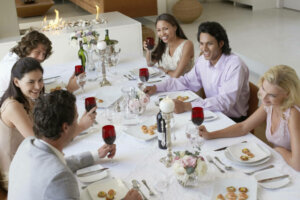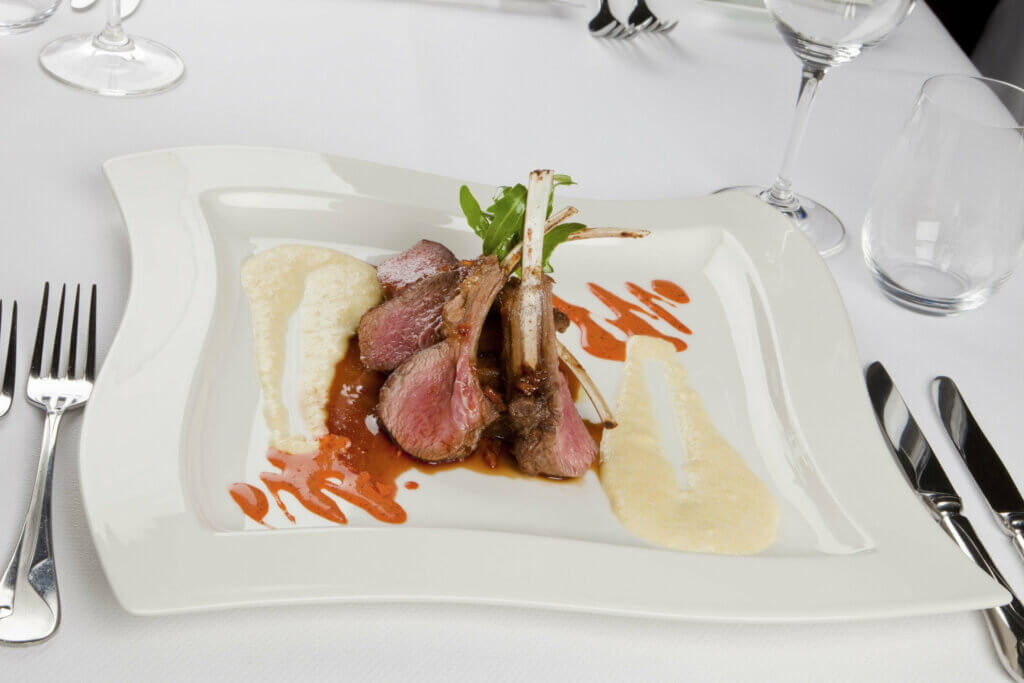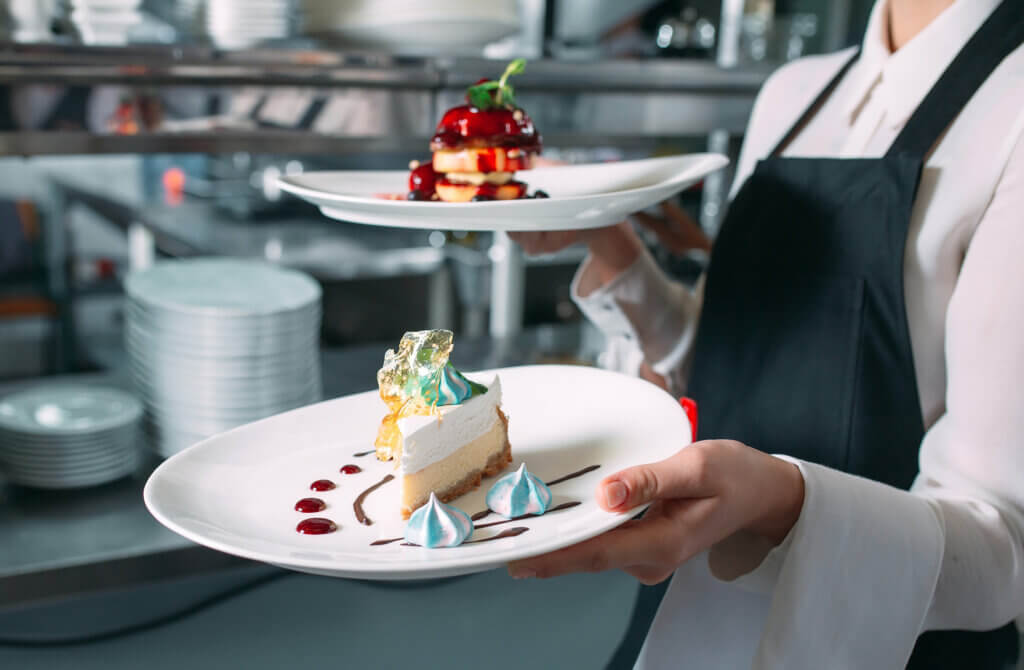Types of Dishes: Their Different Uses and Table Etiquette

It doesn’t matter if you’re attending an event or enjoying an evening in a restaurant. Knowing the different types of dishes that exist, demonstrates table etiquette and the correct protocol. For this reason, we’ll show you the dishes that are most frequently used on formal occasions. Learn about their functions and the basic table rules that apply.
Flat plate

The shallow, flat plate is characterized by having a diameter of about 23 to 25 centimeters. Likewise, it’s one of the most used in gastronomy. Since it’s used to serve the main course, it holds all kinds of food, except for desserts and liquid meals. In general, it’s different from a salad plate.
Types of dishes: bowl
As the name implies, the bowl is deep and this makes it perfect for liquid and semi-liquid foods, such as soups and creams. In addition, its size can vary depending on the occasion or the food it contains.
With formal meals, the bowl is usually shallower, but it has rims and is served on top of another plate. For informal meals, instead, rimless or coupe-type bowls can be used.
Now, if it’s a thick meat soup that retains heat, the recommendation is to serve it in a bowl that disperses high temperatures. On the other hand, if it’s smooth-textured broth or cream, the bowl should be one that manages to keep the contents warm.
Bread plate
Also known as a side plate, it usually measures around 16 centimeters in diameter and, although it’s common for it to be round in shape, there are oval and square models. Likewise, it can be accompanied by a little butter and a spreading knife.
Often the bread plate is placed on the left, next to the fork, and is used to separate the bread and the butter from other foods. At a formal dinner, bread is served between different wines or between different dishes.
Types of dishes: coffee saucer
Since this saucer-type plate is the one that accompanies your cup of coffee, it’s not interchangeable with any other plate. Its usefulness lies in collecting spillages, splashes and drips, as well as preventing spots from appearing on surfaces due to heat. In the same way, it has a groove that prevents the cup from moving and potential accidents.
With a diameter that doesn’t exceed 12 centimeters, the coffee saucer is also the best place to support the teaspoon that you use to mix the sugar, fructose or other sweeteners.
Types of dishes: presentation plate or underplate
Do you remember we mentioned that in a formal meal the bowl was served on another plate? If so, you should already know that this is the presentation plate or underplate. This has a diameter that ranges between 30 and 34 centimeters and, in a restaurant or at an event, it’s part of the table decoration.
However, this isn’t its only role. The underplate protects the tablecloth and the table from food, spills and splashes, as well as helping to keep the food warm.
Salad bowl
This measures between eight and nine inches in diameter. In this, portions of salad are served that can be the first course or a single dish, before or after the main course.
Plate of appetizers
This comes in various sizes, starting at 17 centimeters in diameter, and as its name suggests, it allows for the serving of appetizers such as cheese or cut fruits. Side dishes and some bowls also fall into this category.
Dessert dish

This has a diameter of 18 to 20 centimeters and is thinner and lighter than other types of dishes. Likewise, it’s considered versatile, since it holds cakes, sweets, and ice cream, among other desserts. In general, it’s used at the end of the meal.
Get ready for table etiquette
Knowing the different types of dishes that exist is just the beginning of what you need to know to behave properly at the table. This applies whether you’re at an event, restaurant or even if you’re the host of a formal dinner. The rules of etiquette are linked to self-esteem, culture, and social skills; aspects that build and portray an image of success.
It doesn’t matter if you’re attending an event or enjoying an evening in a restaurant. Knowing the different types of dishes that exist, demonstrates table etiquette and the correct protocol. For this reason, we’ll show you the dishes that are most frequently used on formal occasions. Learn about their functions and the basic table rules that apply.
Flat plate

The shallow, flat plate is characterized by having a diameter of about 23 to 25 centimeters. Likewise, it’s one of the most used in gastronomy. Since it’s used to serve the main course, it holds all kinds of food, except for desserts and liquid meals. In general, it’s different from a salad plate.
Types of dishes: bowl
As the name implies, the bowl is deep and this makes it perfect for liquid and semi-liquid foods, such as soups and creams. In addition, its size can vary depending on the occasion or the food it contains.
With formal meals, the bowl is usually shallower, but it has rims and is served on top of another plate. For informal meals, instead, rimless or coupe-type bowls can be used.
Now, if it’s a thick meat soup that retains heat, the recommendation is to serve it in a bowl that disperses high temperatures. On the other hand, if it’s smooth-textured broth or cream, the bowl should be one that manages to keep the contents warm.
Bread plate
Also known as a side plate, it usually measures around 16 centimeters in diameter and, although it’s common for it to be round in shape, there are oval and square models. Likewise, it can be accompanied by a little butter and a spreading knife.
Often the bread plate is placed on the left, next to the fork, and is used to separate the bread and the butter from other foods. At a formal dinner, bread is served between different wines or between different dishes.
Types of dishes: coffee saucer
Since this saucer-type plate is the one that accompanies your cup of coffee, it’s not interchangeable with any other plate. Its usefulness lies in collecting spillages, splashes and drips, as well as preventing spots from appearing on surfaces due to heat. In the same way, it has a groove that prevents the cup from moving and potential accidents.
With a diameter that doesn’t exceed 12 centimeters, the coffee saucer is also the best place to support the teaspoon that you use to mix the sugar, fructose or other sweeteners.
Types of dishes: presentation plate or underplate
Do you remember we mentioned that in a formal meal the bowl was served on another plate? If so, you should already know that this is the presentation plate or underplate. This has a diameter that ranges between 30 and 34 centimeters and, in a restaurant or at an event, it’s part of the table decoration.
However, this isn’t its only role. The underplate protects the tablecloth and the table from food, spills and splashes, as well as helping to keep the food warm.
Salad bowl
This measures between eight and nine inches in diameter. In this, portions of salad are served that can be the first course or a single dish, before or after the main course.
Plate of appetizers
This comes in various sizes, starting at 17 centimeters in diameter, and as its name suggests, it allows for the serving of appetizers such as cheese or cut fruits. Side dishes and some bowls also fall into this category.
Dessert dish

This has a diameter of 18 to 20 centimeters and is thinner and lighter than other types of dishes. Likewise, it’s considered versatile, since it holds cakes, sweets, and ice cream, among other desserts. In general, it’s used at the end of the meal.
Get ready for table etiquette
Knowing the different types of dishes that exist is just the beginning of what you need to know to behave properly at the table. This applies whether you’re at an event, restaurant or even if you’re the host of a formal dinner. The rules of etiquette are linked to self-esteem, culture, and social skills; aspects that build and portray an image of success.







